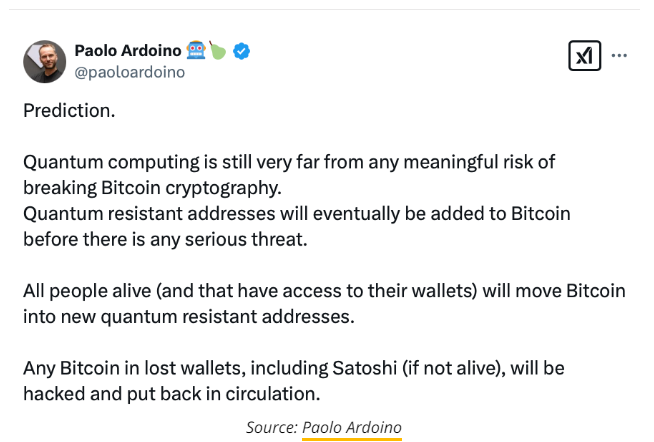Tether CEO Paolo Ardoino claims quantum computing will hack Bitcoin in “lost wallets” and return it to circulation — a move one trader warns could drag Bitcoin back to the “stone ages.”

Tether CEO Paolo Ardoino predicts that quantum computing will eventually hack inactive Bitcoin wallets, returning the Bitcoin in those wallets to circulation.
However, he says this is still a long way off.
“Any Bitcoin in lost wallets, including Satoshi (if not alive), will be hacked and put back in circulation,” Ardoino said in a Feb. 8 X post.
Quantum computing won’t break Bitcoin anytime soon
“Quantum computing is still very far from any meaningful risk of breaking Bitcoin cryptography,” he added.
Quantum computing is a new technology that can handle multiple possibilities and solve complex problems using atomic-level phenomena, which regular computers can’t handle.
Lost Bitcoin wallets are at greater risk as quantum computing advances since there’s no one to protect or move the funds. Active wallets, on the other hand, are more likely to adopt quantum-resistant protection as it becomes available.
He explained that all Bitcoin wallets owned by people still alive and with access to their wallets will be moved into new “quantum-resistant addresses.”

Pseudonymous crypto trader Crypto Skull told their 140,500 X followers that Satoshi Nakamoto’s old wallets being brought back into circulation “could theoretically send us back to the stone age.”
Some experts are of the opinion that Satoshi should have their 1 million Bitcoins frozen to prevent exploitation.
Bitcoin maxis should “plan accordingly”
Echoing a similar sentiment to Ardoino, Bitcoin bull and billionaire Chamath Palihapitiya said in a December X post that “Quantum Computing will be a risk to v1 cryptographic approaches.”
“The time frame is very much not clear, and it’s not in the immediate time horizon. But if I owned a lot of BTC, my risk posture would be to assume it could happen and plan accordingly,” Paliapitya said.
Related: Onchain real-world assets gain traction amid Bitcoin market uncertainty
According to a July 2023 Quantum Grad report, Grover’s search algorithm — a rapid-speed algorithm for searching an unsorted database — is the theoretical standard for the best-optimized way to search for a Bitcoin key.
However, it said it “might take millions of qubits to build a working Grover’s algorithm capable of seamlessly digging up the private key” to Bitcoin wallets.


